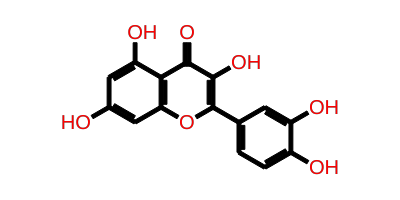- Resources
Recent Activities
Plants Gallery
Downloads
Worldwide, there are plants known as psychoactive plants that naturally contain psychedelic active components. They have a high concentration of neuroprotective substances that can interact with the nervous system to produce psychedelic effects. Despite these plants' hazardous potential, recreational use of them is on the rise because of their psychoactive properties. Early neuroscience studies relied heavily on psychoactive plants and plant natural products (NPs), and both recreational and hazardous NPs have contributed significantly to the understanding of almost all neurotransmitter systems. Worldwide, there are many plants that contain psychoactive properties, and people have been using them for ages. Psychoactive plant compounds may significantly alter how people perceive the world.
Compound Summary
CAS ID |
N/A |
||
INCHI KEY |
REFJWTPEDVJJIY-UHFFFAOYSA-N |
||
MOLECULAR WEIGHT |
302.23 |
||
MOLECULAR FORMULA |
C15H10O7 |
||
MOLECULAR MASS |
302.238 |
||
BIOLOGICAL SOURCE |
Schinus terebinthifolius |
||
DATA SOURCE |
U.S. Department of Agriculture, Agricultural Research Service. 1992-2016. Dr. Duke's Phytochemical and Ethnobotanical Databases. Home Page, http://phytochem.nal.usda.gov/ http://dx.doi.org/10.15482/USDA.ADC/1239279 | ||
CHEMICAL CLASS OF COMPOUND |
Flavonoids |
||
NLRP3 DOCKING SCORE(Kcal/mol) |
-8.419 |
||
CANONICAL SMILES O=c1c(O)c(-c2ccc(O)c(O)c2)oc2cc(O)cc(O)c12
|
|||
BIOACTIVITY REPORTED FOR NEURODEGENERATIVE DISEASES
Yes
|
|||
SYNONYMS |
quercetin, 117-39-5, Sophoretin, Meletin, Quercetine, Xanthaurine, Quercetol, Quertine, Quercitin, 2-(3,4-Dihydroxyphenyl)-3,5,7-trihydroxy-4H-chromen-4-one, 3,3',4',5,7-Pentahydroxyflavone, Cyanidelonon 1522, Flavin meletin, 3,5,7,3',4'-Pentahydroxyflavone, Quertin, T-Gelb bzw. grun 1, C.I. Natural Yellow 10, Quercetin content, Kvercetin, C.I. 75670, C.I. Natural red 1, Cyanidenolon 1522, 2-(3,4-Dihydroxyphenyl)-3,5,7-trihydroxy-4H-1-benzopyran-4-one, CI Natural Yellow 10, Corvitin, Korvitin, Lipoflavon, 3',4',5,7-Tetrahydroxyflavan-3-ol, 2-(3,4-dihydroxyphenyl)-3,5,7-trihydroxychromen-4-one, C.I. Natural yellow 10 & 13, Flavone, 3,3',4',5,7-pentahydroxy-, NSC 9219, CCRIS 1639, 4H-1-Benzopyran-4-one, 2-(3,4-dihydroxyphenyl)-3,5,7-trihydroxy-, HSDB 3529, NCI-C60106, 3'-hydroxykaempferol, CHEBI:16243, NSC9219, 3,5,7-Trihydroxy-2-(3,4-dihydroxyphenyl)-4H-chromen-4-on, AI3-26018, UNII-9IKM0I5T1E, C15H10O7, NSC-9219, EINECS 204-187-1, 9IKM0I5T1E, MFCD00006828, Quercetin (GMP), 3',4',5,7-tetrahydroxyflavon-3-ol, BRN 0317313, CI 75670, DTXSID4021218, 3,3',4,5,7-Pentahydroxyflavone, 2-(3,4-dihydroxyphenyl)-3,5,7-trihydroxy-chromen-4-one, CHEMBL50, Ci-75670, NSC-57655, LDN-0052529, Flavone, 3,4',5,5',7-pentahydroxy-, DTXCID001218, 2-(3,4-Dihydroxy-phenyl)-3,5,7-trihydroxy-chromen-4-one, 3,5,7-trihydroxy-2-(3,4-dihydroxyphenyl)-4H-chromen-4-one, Quercetin (constituent of ginkgo), 5-18-05-00494 (Beilstein Handbook Reference), 3,5,7,3',4'-Pentahydroxyflavon, Kvercetin [Czech], Natural Yellow 10, QUERCETIN (IARC), QUERCETIN [IARC], QUERCETIN (USP-RS), QUERCETIN [USP-RS], QUE, BRD9794, Dikvertin, BRD-9794, 2-(3,4-DIHYDROXYPHENYL)-3,5,7-TRIHYDROXY-4H-BENZOPYRAN-4-ONE, CAS-117-39-5, 3,5,7,3',4'-pentahydroflavone, NSC57655, NSC58588, SR-01000076098, MixCom3_000183, Ritacetin, Quer, Quercetin,, 74893-81-5, 4dfu, 4mra, Quercetin2H2O, Meletin;Sophoretin, Quercetin Phenolic, KUC104418N, KUC107684N, LIM-5662, LNS-5662, TNP00070, TNP00089, Quercetin1540, CI Natural Red 1, KSC-23-76, Quercetin_sathishkumar, KSC-10-126, Quercetin (Sophoretin), Spectrum_000124, Tocris-1125, 3cf8, QUERCETIN [DSC], QUERCETIN [MI], BiomolKI_000062, QUERCETIN [HSDB], Maybridge1_008992, Prestwick0_000507, Prestwick1_000507, Prestwick2_000507, Prestwick3_000507, Spectrum2_000059, Spectrum3_000642, Spectrum4_000807, Spectrum5_001389, Lopac-Q-0125, QUERCETIN [VANDF], P0042, BiomolKI2_000068, Enicostemma Littorale Blume, UPCMLD-DP081, Q 0125, QUERCETIN [WHO-DD], NCIOpen2_007628, NCIOpen2_007882, BIDD:PXR0007, Lopac0_000999, SCHEMBL19723, BSPBio_000433, BSPBio_001068, BSPBio_002243, KBioGR_000408, KBioGR_001293, KBioSS_000408, KBioSS_000584, MLS006011766, BIDD:ER0315, DivK1c_000485, SCHEMBL219729, SPECTRUM1500672, T-GELB BZW, GRUN 1, CU-01000012502-3, SPBio_000217, SPBio_002354, BDBM7460, BPBio1_000477, GTPL5346, MEGxp0_000381, SGCUT00001, 3,4',5,7-Pentahydroxyflavone, CI Natural Yellow 10 & 13, NIOSH/LK8760000, UPCMLD-DP081:001, ACon1_000560, HMS501I07, KBio1_000485, KBio2_000408, KBio2_000584, KBio2_002976, KBio2_003152, KBio2_005544, KBio2_005720, KBio3_000775, KBio3_000776, KBio3_001463, 3,7,3',4'-Pentahydroxyflavone, NINDS_000485, 3',4',5,7-tetrahydroxyflavonol, 3',5,7-Tetrahydroxyflavan-3-ol, Bio1_000369, Bio1_000858, Bio1_001347, Bio2_000374, Bio2_000854, HMS1362F09, HMS1792F09, HMS1923O19, HMS1990F09, HMS3263G19, HMS3267M12, HMS3414J21, HMS3649D04, HMS3656C15, HMS3678J19, to_000078, 3,4',5,5',7-pentahydroxyflavone, Tox21_202308, Tox21_300285, Tox21_500999, BBL005513, CCG-40054, Flavone,3',4',5,7-pentahydroxy-, HB0542, HY-18085G, LMPK12110004, NSC 57655, NSC324608, NSC756660, s2391, STK365650, Quercetin, >=95% (HPLC), solid, 3,4',5,5',7-pentahydroxy-Flavone, AKOS000511724, Quercetin 1000 microg/mL in Acetone, CS-3981, DB04216, DS-3416, LP00999, NSC-756660, SDCCGSBI-0050972.P003, SDCCGSBI-0050972.P010, IDI1_000485, IDI1_002129, LDN 0052529, SMP1_000252, NCGC00015870-01, NCGC00015870-02, NCGC00015870-03, NCGC00015870-04, NCGC00015870-05, NCGC00015870-06, NCGC00015870-07, NCGC00015870-08, NCGC00015870-09, NCGC00015870-10, NCGC00015870-11, NCGC00015870-12, NCGC00015870-13, NCGC00015870-14, NCGC00015870-15, NCGC00015870-16, NCGC00015870-17, NCGC00015870-18, NCGC00015870-19, NCGC00015870-21, NCGC00015870-22, NCGC00015870-23, NCGC00015870-24, NCGC00015870-25, NCGC00015870-28, NCGC00015870-36, NCGC00015870-48, NCGC00015870-50, NCGC00025016-01, NCGC00025016-02, NCGC00025016-03, NCGC00025016-04, NCGC00025016-05, NCGC00025016-06, NCGC00025016-07, NCGC00025016-08, NCGC00168962-01, NCGC00168962-02, NCGC00168962-03, NCGC00168962-04, NCGC00254218-01, NCGC00259857-01, NCGC00261684-01, Quercetin 100 microg/mL in Acetonitrile, AC-19596, AC-29756, HY-18085, NCI60_042036, SMR000112559, SY057722, (+)-3,3',4',5,7-Pentahydroxyflavone, Quercetin, Sophoretin, Meletin, Quercetine, CS-0638666, EU-0100999, LK87600000, NS00001142, Q0025, SW148203-4, Quercetin; 3,3',4',5,7-Pentahydroxyflavone, C00389, EN300-199773, K00029, S00057, QUERCETIN (CONSTITUENT OF GINKGO) [DSC], WLN: T66 BO EVJ CR CQ DQ & DQ GQ IQ, 2-(3,4-Dihydroxyphenyl)-4H-1-benzopyran-4-one, Flavone, 3,3',4',5,7-pentahydroxy-, (+)-, Q409478, Q-200333, SR-01000076098-1, SR-01000076098-3, SR-01000076098-7, SR-01000076098-8, BRD-K97399794-001-02-1, BRD-K97399794-001-07-0, BRD-K97399794-001-09-6, BRD-K97399794-001-11-2, BRD-K97399794-001-14-6, BRD-K97399794-001-15-3, BRD-K97399794-001-16-1, BRD-K97399794-335-03-1, BRD-K97399794-335-05-6, BRD-K97399794-335-06-4, SR-01000076098-11, Z57176222, 2-(3,4-dihydroxyphenyl)-3,5,7-trihydroxy-chromone;hydrate, 49643640-FD4C-4B93-BD28-0D7C2021CC52, 2-(3,4-Dihydroxyphenyl)-3,5,7-trihydroxy-4H-chromen-4-one #, (+)-4H-1-Benzopyran-4-one, 2-(3,4-dihydroxyphenyl)-3,5,7-trihydroxy-, 4H-1-Benzopyran-4-one,2-(3,4-dihydroxyphenyl)-3,5,7-trihydroxy-,zirconium(2+)salt(1:1) |
||
